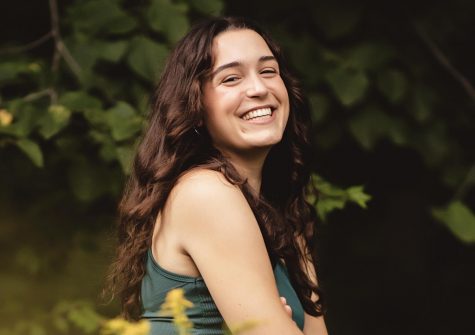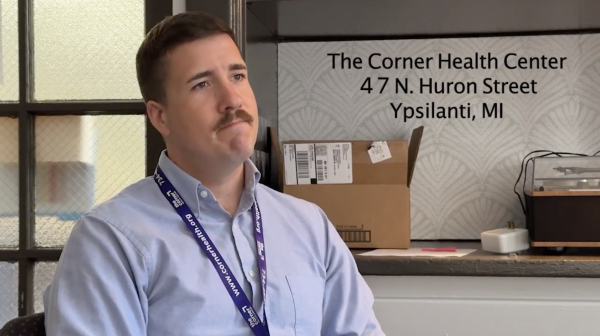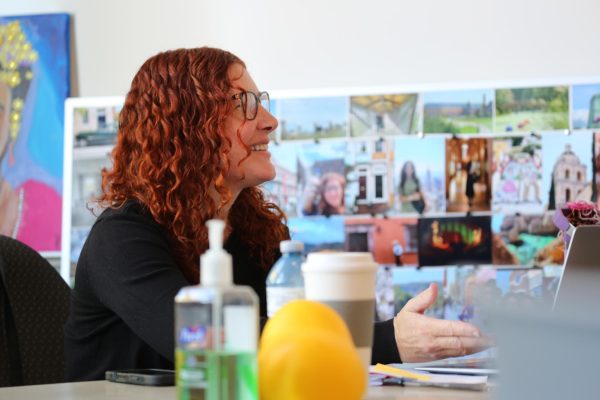No Playground: Kindergarten Through a Screen
Thomas Clarkson has always taught his students with humor and affection. As a first grade teacher at Martin Luther King Jr. Elementary School, Clarkson believes that watching his students learn, laugh and grow was the reason why he decided to become a teacher in the first place. However, entering a year where he would teach a class of 20 six-year-olds entirely virtually, Clarkson didn’t know whether he would still be able to form the connections with his students that he valued so deeply.
“At first, I was worried that I was not going to be able to make a connection with the kids because I love kids so much, and I want to help them,” Clarkson said. “That was a big thing, but I have grown to love these kids online — even though I’ve never met them in person. I can sense their personalities and figure out who they are. We joke around, and I still use my humor, which is not funny to adults, but to kids it’s funny.”
It has been a long road, learning how best to teach students online, especially those who have had little to no experience learning in a classroom environment. Much of early elementary education involves social development. In addition to the curriculum, kids learn how to interact with their peers, how to behave in a school environment and how to pay attention for longer periods of time. Many of these skills are difficult to develop through online learning.
“There are a lot of things that kids have to learn how to navigate socially, like stealing a pencil, giving a dirty look, dilly-dallying in the hallway while putting their coats up,” Clarkson said. “Some kids will pee all over in the bathroom.”
These kinds of learning experiences may be lost or significantly altered when students are unable to attend school in-person. Other unique challenges — such as navigating and explaining technology to students, regulating parental involvement in school work and keeping students focused —have also arisen for early elementary teachers over the course of this school year. Diana Gatonez teaches kindergarten, and in her experience, certain students struggle more than others with maintaining focus during class. One of her students in particular has had this issue.
“He’s the type of child that cannot be in front of a computer for a very long period of time, so the challenge is how to get that particular child to stay engaged,” Gatonez said. “At the same time, in this setting, how much can you expect from a little kindergartener?”
Students and teachers alike have been challenged in new ways over the course of the past few months. Back in September, teachers were confronted with the task of instructing their students and using unfamiliar platforms and policies, all while helping students adapt to these same changes.
“At the very beginning, it was horrific,” Clarkson said. “I lost a lot of sleep.”
However, support and collaboration between teachers, especially those of the same grade, have helped to address many of the initial concerns and challenges that emerged. According to Clarkson and Gatonez, as part of this collaboration, teachers of the same grade meet every week to share and develop lesson plans.
“We meet on Wednesdays, from one until three, and we talk about the curriculum, how to teach the curriculum and any kind of suggestions, helpful hints or strategies,” Clarkson said.
The plans developed in these meetings can then be molded to fit the level and needs of a teacher’s specific classroom. This helps teachers share the work while still ensuring that students are learning at the right level and pace.
“I follow the general lesson format, but then, to teach it to my kids, I completely take out a whole bunch of things that I personally don’t think are appropriate for my class,” Gatonez said. “For example, if the math lessons are a little too easy, we modify, and we make them a little harder for our students.”
After five months of implementing changes like these, not only has online teaching and learning improved, but there are even some unforeseen benefits.
“Some of the parents are becoming more aware of exactly what kids should know,” Clarkson said. “[Before this year], papers would come home in a folder, and parents would look at their [kid’s] work and say, ‘Oh you did well in this,’ but they don’t know how much involvement the teacher had to get the kid to do that. They don’t know that I sat with the kid for 20 minutes one-on-one, trying to explain it, but now they can see that.”
Additionally, according to Gatonez, despite the many challenges of this year’s distanced learning, she can still see growth and development among her students.
“They’re soaking up the information,” Gatonez said. “We didn’t know how much they would learn by this time, but now they are [learning]. I’ve been impressed.”
It makes Gatonez happy to see her students growing and gaining confidence in their knowledge and interaction with their peers. She noted that many kids were timid in the beginning, but as they grew accustomed to the routines of virtual school, she was able to see them come out of their shells.
“I have some [students] that are feeling very comfortable, and when I go and visit them [in their breakout rooms], they’re showing each other their favorite stuffed animals, and they’re giggling,” Gatonez said.
Most of her students love connecting with the other kids online, and Gatonez has developed strategies to keep her students engaged throughout the school day.
“I have puppets, and I dress up to keep their attention,” Gatonez said. “For science, I dressed up as a doctor, and I changed my accent, so they feel like it’s funny.”
She also teaches in 30-minute increments with breaks for asynchronous activities in between. This helps to minimize students’s attention span issues and limit their time spent in front of a screen.
Strategies like these have successfully helped teachers and students acclimate to a virtual school environment and routine. However, developing and executing these practices has been a long and arduous process for teachers. This fact, as well as the numerous social benefits of in-person schooling for young elementary-aged children, have caused many to push for a return to the classroom. Clarkson and Gatonez have a slightly different view.
“I don’t think it’s right that we would go back before we can get a vaccination,” Clarkson said. “[People] don’t know all the stuff that goes on [in the classroom].”
He proceeded to explain that first grade children can be dirty, and it is hard to enforce boundaries with kids so young. Mandating mask-wearing and social distancing for 20 six-year-olds in one classroom would be very difficult for teachers. He also brought up the issue of lunchtime at school.
“The restaurants are closed because they’re supposed to be a source of contamination or exposure,” Clarkson said. “Well, if you can’t open a restaurant, why can you open your cafeteria? Isn’t that the same thing? It seems like mixed messages.”
Gatonez voiced some of the same concerns, as well as the issues of having to establish brand new routines with kindergarteners and coordinate the combination of virtual and in-person teaching.
“We haven’t been informed on how things are going to go,” Gatonez said. “I do know some kids will only go two days, and some kids are going to go the other two days, but what am I going to do with the kids that are not there? Am I teaching them virtually?”
She went on to explain, “I would love to see my students. They’re just such a fun group, and I really want to see them in person, but [people] need to think about how [going back in person] is really going to be.”









